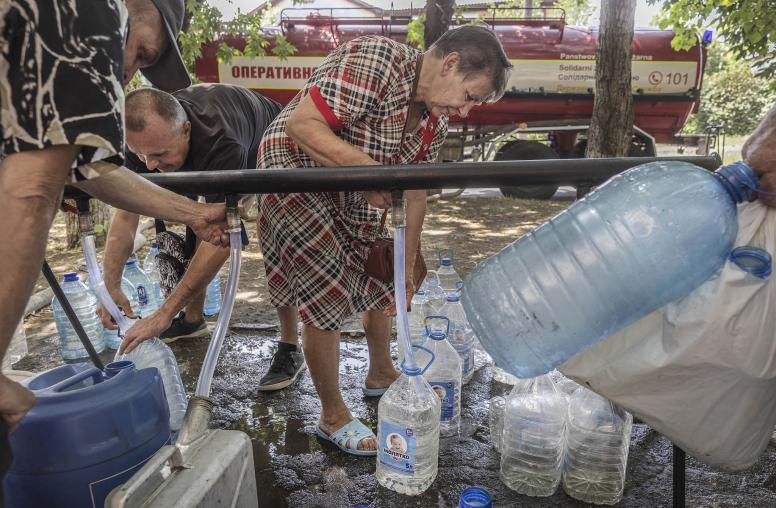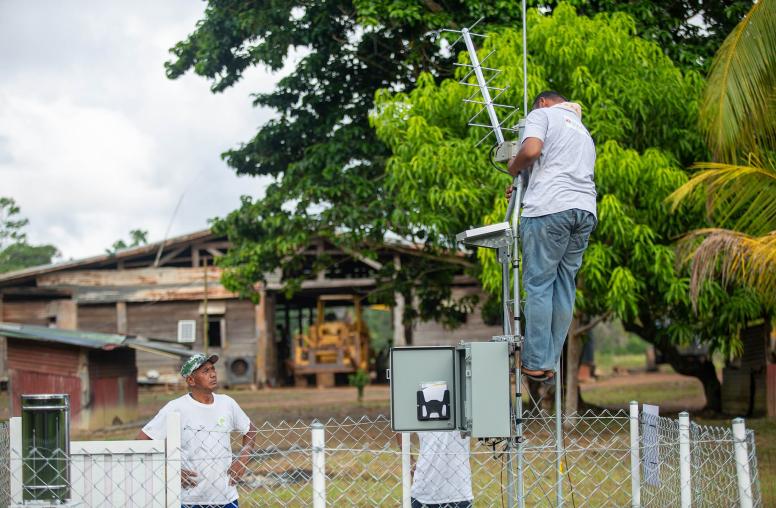Fragile States Require Unified Response, Lindborg Says
USIP Chief Tells World Bank Forum Economic, Humanitarian Goals Are Inseparable
U.S. Institute of Peace President Nancy Lindborg called for united action by humanitarian and economic development organizations, telling the opening session of the World Bank’s 2016 “Fragility Forum” that peace, development and security are inextricably linked in today’s world crises.

The forum this week in Washington, with more than 1,200 registered participants from over 100 organizations, should mark an inflection point in addressing natural and man-made disasters, she said. Development organizations that promote fragile countries’ economic growth and humanitarian aid agencies that pick up the pieces after catastrophes need to refocus on building stronger societies and more legitimate, effective governments that can avoid and recover from economic and social shocks, Lindborg said.
“We don’t have a refugee crisis. We have a fragility, conflict and violence crisis.” – USIP President Nancy Lindborg
The forum takes place against a backdrop of particular upheaval globally that, as Lindborg noted, has more than 1 billion people living in fragile states plagued by violence, conflict and poverty. The tide of displaced people pouring into Europe from the Middle East, Africa and beyond is a symptom of those catastrophes.
“We don’t have a refugee crisis. We have a fragility, conflict and violence crisis,” Lindborg said. “My great hope is we will not lose our focus on looking at the roots of that very difficult issue.”
The three days of panel discussions with international officials, government authorities and experts from around the world focused on the need to build peaceful and inclusive societies and explored questions such as the origins of societal breakdowns and how to make development more sustainable. USIP was a partner in the forum, and Lindborg and five other institute experts spoke on panels or moderated sessions. USIP recently formed a Senior Study Group on Fragility with the Carnegie Endowment for International Peace and the Center for a New American Security to make recommendations for ways the U.S. government can improve its approach to global fragility.
In the same opening discussion at the World Bank forum, United Nations Deputy Secretary-General Jan Eliasson agreed that the time for “organizational provincialism” is over. He outlined the grim toll of fragile states and conflict zones.
Wars, Extremism, 'Conflict Systems'
The number of civil wars has tripled from 2007 to 2014, and wars have become larger and more intense, he said. Some 60 million people are displaced around the world—more than at any time since World War II. Combatants show increasing disrespect and disregard for international law, he said. Lindborg, citing testimony by U.S. National Intelligence Director James Clapper, added that violent extremists are active in about 40 countries while central governments are threatened in 14 and collapsing in seven.
World Bank Group President Jim Yong Kim noted that terrorist incidents more than doubled in 2014 from two years earlier. In Africa, violent struggles increasingly morph into “conflict systems” that spill across borders.
“It should come as no surprise, then, that addressing the root causes of conflict and insecurity is a core priority of the World Bank Group,” said Kim. The Bank’s declared mission is to end extreme poverty within a generation and boost shared prosperity. But, even as the extreme poverty rate falls below 10 percent of the world’s population for the first time, displacement and destruction generated by violence has surged, he said.
“We now have to admit that the paradigms and frameworks that have guided our perspective on fragility and conflict may be less relevant than we had hoped,” Kim said.
The forum, he said, is the bank’s effort to seek new ideas for a “collective response” to fragility and conflict.
Lindborg argued that the international community must get ahead of the crises that so frequently originate in fragile states. In part, early action would involve applying pressure to achieve the UN’s Sustainable Development Goal 16, which calls for “just, peaceful and inclusive societies,” she said. Directing development funds to address fragility, rather than poverty alone, would ultimately reduce the cost of development programs that aim to stimulate economic progress in those countries and their regions, she said.
“We have all seen decades of development destroyed in a firefight, bombings and by rampant militias,” she said.
Fragility's Impact
In a later discussion on “Fragility, Conflict and Disaster Risk,” Lindborg said the ability to handle natural disasters such as drought or floods—which are increasingly frequent with climate change—is also a function of fragility and, conversely, the ability of societies to withstand shocks. International work that helps local citizens and authorities establish legitimate, inclusive government is critical, said Lindborg, who worked on disaster response as president of Mercy Corps and deputy administrator of the Bureau for Democracy, Conflict and Humanitarian Assistance at the U.S. Agency for International Development.
The Ebola virus outbreak in Liberia and Sierra Leone in 2014 and 2015 is an example of fragility’s impact, Lindborg said. While both countries had weak health systems, another reason the disease spread so intensely is because these nations were still emerging from civil wars with widely mistrusted governments. The public accepted information about the epidemic as valid only after faith and tribal leaders stepped in, she said, causing critical delays in response.
Identifying fragility also can provide an opportunity, perhaps during a period of transition when systems and institutions need to be rebuilt, said Manal Omar, USIP’s acting vice president for Middle East and Africa programs, after a panel discussion she participated in that focused on advances in the research and practice of dialogue and negotiation. Preferably preemptive action would take place at the local level, before a crisis spreads more widely and to national structures, she said.
“Why not seize the opportunity for rebuilding governance structures or social structures in a more resilient and inclusive way instead of the old models?” Omar said. “These crises are frequently linked to internal and external stresses ranging from rapid political transformations, systemic youth unemployment, acute corruption, global market volatility, transnational organized crime and climate change.”
Corruption and voting fraud allegations also can lead to violence before, during or after elections, spurred by citizen frustration or a brutal government response, said Jonas Claes, a USIP senior program officer, in a panel discussion on reducing electoral violence that was moderated by Lauren Van Metre, the institute’s acting vice president for applied research on conflict. Another panel on “Innovative Tools for Responding to Crises” was moderated by Ethan Kapstein, a senior advisor for economics and peacebuilding at USIP who also serves as associate director of the Empirical Studies of Conflict research collaborative and senior director of Arizona State University’s McCain Institute for International Leadership in Washington D.C.
Still, peaceful elections are no guarantee of the quality of a democracy, just as free and fair elections are no guarantee of election security. The 2011 balloting in Nigeria illustrate this paradox: while the vote was more transparent and less corrupt than previous elections, “the country still experienced quite intense election violence,” Claes said.
Carla Koppell, a former chief strategy officer for USAID who recently joined USIP as vice president for applied conflict transformation, spoke on a panel exploring gender disparities. She said foreign assistance must fully take into account a society’s gender issues and also ensure that local leaders and citizens can speak powerfully for themselves to shape interventions effectively.
It’s important “not to forget that they are the change agents that will transform their societies and move the agenda forward,” she said.



